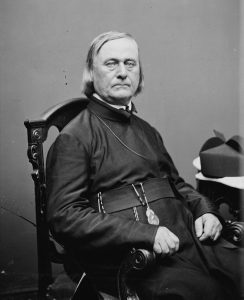History is full of examples of fortitude in the face of adversity. One such figure is Father Pierre De Smet, S.J. This priest faced physical hardship and dangers as he gave everything for the salvation of souls. He even confronted the plague, which should serve as a lesson for our time.
Men of Different Caliber
Our hero was born in Belgium in 1801. One day, the pious youth heard an old missionary priest tell stories about evangelizing the Indians in far-away America. He was inspired by this life fraught with danger and adventure and decided it was worth the risks because the salvation of souls was the goal. The young De Smet soon ran away from home and eventually became a Jesuit in America.
Boot Camp Novitiate
During his novitiate in Whitemarsh, Maryland, food became scarce. To alleviate the situation, the Jesuits decided to accept a bishop’s offer of a farm in Florissant, Missouri on the outskirts of Saint Louis.
Thus began a long trek to Florissant, all the while continuing their religious exercises and studies! Along the way, they stopped at Cincinnati and Louisville. To facilitate the travel, they sent their baggage ahead by boat and walked to their new home. The travelers endured long days in the wilderness and chest-deep swamps.
Finally, they arrived in Florissant, where they found some small run-down dwellings barely able to accommodate them. The priests and seminarians immediately got to work by chopping down trees and gathering materials. Soon they had new dwellings and classrooms. All the while, they continued their studies and ministered to the locals. They were real men indeed.
Fr De Smet would later fulfill his dream of being a missionary to the Indians. He would earn the title of Apostle of the Rocky Mountains. He routinely traveled thousands of miles across oceans, through wilderness, bad weather, or flooded rivers. He risked death by facing natural disasters, tomahawks or wild beasts. He even faced a plague far more deadly than the coronavirus…
The Jesuits of St. Louis Face the Plague
The Jesuits of the nineteenth century were profoundly Catholic priests that did not flee from death and suffering. The members of the Company of Jesus were shock troops at the service of the Catholic Faith. In times of crisis, they were ready to sacrifice themselves for the good of souls and even expected it.
In 1849, Fr. De Smet was the assistant Vice-Provincial of the Jesuit Province of Missouri when cholera struck Saint Louis. An account of this episode is found in the book, The Life of Father De Smet, S.J. by Father E. Laveille. He tells how “It [cholera] claimed as many as two hundred victims a day during a period of several months.”
“There is general mourning,” wrote Father De Smet of the outbreak. “All who have the means leave the city; business is dead. Often, friends whom I have seen in the morning are lying in their coffins in the evening.”
Classes at the University of Saint Louis continued. The Jesuits on staff were overwhelmed with sick calls. At times, Fr. De Smet was so busy that he remained in the same cassock night and day.
The staff and two hundred boarders of the university did not leave. They did what all true Catholics do in times of trial; they had recourse to Our Lady. Professors and students promised her a silver crown if they all survived the plague. This intercession was most urgent because the school was in a cholera hot spot.
Modern church leaders, wise in the ways of the world, may be surprised to learn that Our Lady heard their prayers. None of the priests or students died! No one missed a single day of class. After the plague ceased, they solemnly thanked Our Lady by crowning her statue and carrying it in procession.
The Grandeur of Self-Immolation
Two years later, Fr. De Smet joined Fr. Christian Hoecken on a steamboat trip to carry out a mission to the Indians. The river was flooded exposing the boat to trees, dwellings and other debris. Suddenly, cholera broke out on board. The dead and dying mounted rapidly. The two Jesuits did not flee but charged into the fray.
They brought the consolation of the Sacraments to those facing death. Soon Fr. De Smet fell deathly ill. In his weak voice, he asked Fr. Hoecken for Extreme Unction. The latter told Fr. De Smet he must wait. There were others sicker than him that had priority.
Later, Fr. Hoecken called him for help from the adjacent cabin. When Fr. De Smet dragged himself to meet his companion, he found the priest at death’s door. In a scene worthy of a painting, the half-dead Fr. De Smet administered Last Rites to his brave, yet dying companion. In his turn, he asked Fr. Hoecken for absolution, which he gave in a faint, weak voice before expiring. As Providence would have it Fr. De Smet recovered and continued the mission.
Fr. Pierre De Smet was a marvelous example of fortitude, who understood sacrifice and suffering. His ardent faith enabled him to carry the cross. An old saying teaches that “words inspire, but examples draw.” May our hero inspire the reader to imitate his fortitude, especially when the call of duty entails the risk of losing one’s health.
***
